
The Ministry for State Security, commonly known as the Stasi, was the state security service and secret police of East Germany from 1950 to 1990.
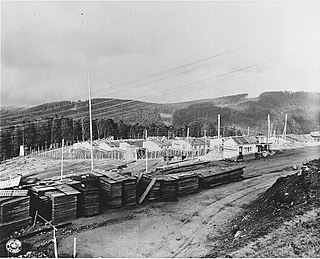
Natzweiler-Struthof was a Nazi concentration camp located in the Vosges Mountains close to the villages of Natzweiler and Struthof in the Gau Baden-Alsace of Germany, on territory annexed from France on a de facto basis in 1940. It operated from 21 May 1941 to September 1944, and was the only concentration camp established by the Germans in the territory of pre-war France. The camp was located in a heavily forested and isolated area at an elevation of 800 metres (2,600 ft).

Sachsenhausen or Sachsenhausen-Oranienburg was a German Nazi concentration camp in Oranienburg, Germany, used from 1936 until April 1945, shortly before the defeat of Nazi Germany in May later that year. It mainly held political prisoners throughout World War II. Prominent prisoners included Joseph Stalin's oldest son, Yakov Dzhugashvili; assassin Herschel Grynszpan; Paul Reynaud, the penultimate prime minister of the French Third Republic; Francisco Largo Caballero, prime minister of the Second Spanish Republic during the Spanish Civil War; the wife and children of the crown prince of Bavaria; Ukrainian nationalist leader Stepan Bandera; and several enemy soldiers and political dissidents.

Werner Teske was an East German Hauptmann (Captain) of the Ministry for State Security (Stasi). Teske was a senior intelligence officer in the Stasi's economic espionage division when he was accused of plotting to defect to West Germany with sensitive information and embezzled money. In the one-day trial, Teske was found guilty of espionage and desertion. He was sentenced to death and subsequently executed in June 1981.

Herzogenbusch was a Nazi concentration camp located in Vught near the city of 's-Hertogenbosch, Netherlands. The camp was opened in 1943 and held 31,000 prisoners. 749 prisoners died in the camp, and the others were transferred to other camps shortly before Herzogenbusch was liberated by the Allied Forces in 1944. After the war, the camp was used as a prison for Germans and for Dutch collaborators. Today there is a visitors' center which includes exhibitions and a memorial remembering the camp and its victims.

Capital punishment in Germany has been abolished for all crimes, and is now explicitly prohibited by the constitution. It was abolished in West Germany in 1949, in the Saarland in 1956, and East Germany in 1987. The last person executed in Germany was the East German Werner Teske, who was executed at Leipzig Prison in 1981.

Josef Blösche was a convicted war criminal and a member of the Nazi Party who served in the SS and SD during World War II. Blösche shot and killed many Jews, and helped send many more Jews to their deaths in extermination camps. He also participated in several massacres.

Horst Paul Silvester Fischer was a German medical doctor and member of the SS who participated in selections in Auschwitz-Birkenau concentration camp during World War II. He selected at least 70,000 prisoners to be gassed, then supervised their gassings. Although he avoided immediate detection after the war, Fischer's crimes came to light in the late 1950s. After tracking him down, Fischer was arrested by East German secret police officials in 1965. In a high-profile public case tried directly by the Supreme Court of East Germany, Fischer, the highest-ranking concentration camp doctor to ever stand trial in front of a German court, was found guilty of crimes against humanity and condemned to death. He was executed by guillotine in 1966.
Erna Dorn was a victim of the politicised justice system in the German Democratic Republic. She is believed to be the only female to have been sentenced and executed in the aftermath of the East German uprising of 1953.
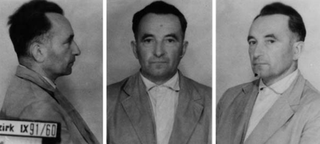
Horst Petri and Erna Petri were married Nazi war criminals during World War II.
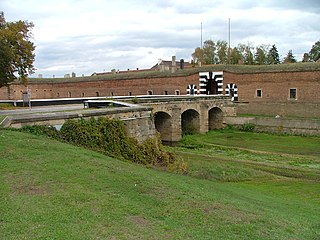
The Small Fortress is a fortress forming a significant part of the town of Terezín in the Czech Republic. The former military fortress was established at the end of the 18th century together with the whole town of Terezín on the right bank of the Ohře River. It served as a prison in the 19th century and was also house of Imprisonment for Gavrilo Princip.

The Memorial and Education Centre Andreasstraße, is a museum in Erfurt, Germany, which is housed in a former prison used by the East German Ministry for State Security (Stasi). It is informally known as the Stasi Museum.

Albert Hugo Schuster was a Nazi war criminal who was responsible for police units in occupied Poland in World War II. He was notorious for his brutality, earning the nickname "The Butcher of the Łysogóry". Schuster avoided detection after the war. After Polish investigators reopened an active search for Nazi war criminals, they discovered Schuster, who was now living in East Germany. Schuster was arrested and put on trial for his crimes by an East German court. He was found guilty, sentenced to death, and executed in 1973.

The Lübschützer Teiche Bunker Complex, built 1968–1972, was designed to be an emergency command centre for the District Administration for State Security, Leipzig in the event of war or a nuclear attack. It was never used for its intended purpose.

Paul Hermann Feustel was a member of the Nazi Party who served in the SS and the Gestapo during World War II. During the war, he would eventually reach the rank of Hauptsturmführer, and committed numerous atrocities in Czechoslovakia, including the ordering of a massacre after Germany's surrender. Feustel initially managed to avoid detection after the war. However, he was arrested by East German authorities in 1971. Feustel was found guilty of war crimes and crimes against humanity, sentenced to death, and executed in 1973.
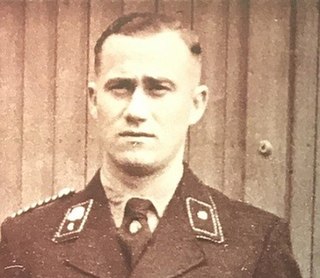
Roland Puhr was an SS-Unterscharführer who committed numerous atrocities at Sachsenhausen concentration camp during World War II. After the war, he settled down in East Germany using forged papers. Puhr was exposed as a war criminal in 1963, and executed the following year.

Hans Anhalt was a member of the Nazi Party who served in the SS. During World War II, he was stationed in Auschwitz concentration camp. There, Anhalt personally murdered multiple prisoners, selecting them to be gassed or experimented on. After the war, he settled down in East Germany, until being exposed in 1962. Anhalt was sentenced to life in prison, where he died in 1975.
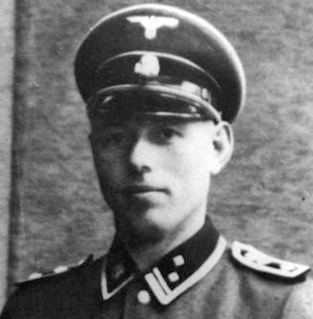
Wilhelm Schäfer was an SS-Hauptscharführer who was complicit in numerous war crimes, including the executions of hundreds of prisoners in Buchenwald concentration camp. He was exposed as a war criminal, put on trial, and executed after he was recognized by a survivor of Buchenwald.

The Committee of Antifascist Resistance Fighters (KdAW) was an anti-fascist organization in the German Democratic Republic. It was composed of both victims of the Nazi regime and resistance fighters against Nazism.





















